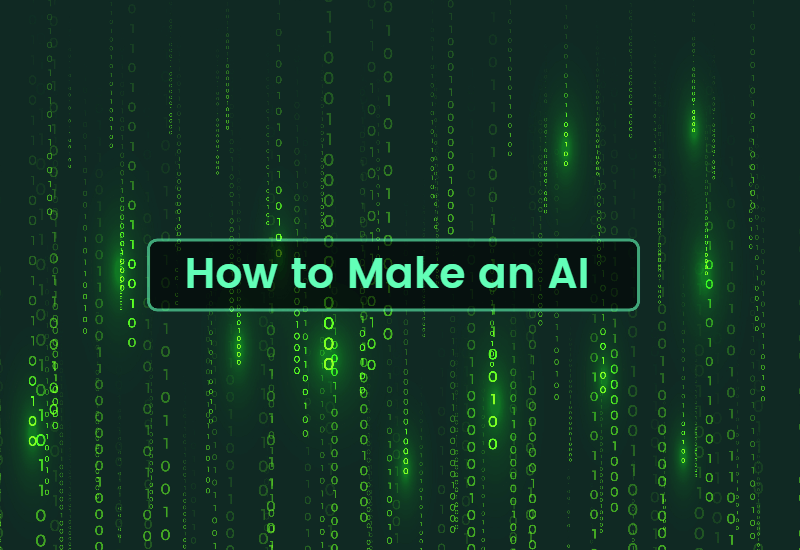How to Make an AI: A Comprehensive Guide for Beginners

"AI" has become a buzzword today, AI systems and products emerge in endlessly, so how to make an AI?
This article aims to provide guidance on the process and steps involved in creating artificial intelligence. By learning how to make your own AI, you can tap into this exciting field, unlocking opportunities for innovation and problem-solving. Whether you're interested in developing AI for a specific task or want to gain a deeper understanding of the underlying principles, this guide will equip you with the necessary knowledge to get started.
What is AI?
Before diving into the technical aspects of building AI, it's important to grasp the fundamental concepts behind this remarkable technology.
AI refers to the development and implementation of intelligent machines that can perform tasks that typically require human intelligence. The goal of AI is to mimic and simulate human cognitive abilities, such as problem-solving, pattern recognition, natural language processing, and decision-making.
AI Applications
Artificial Intelligence has a wide range of applications across various industries, including:
1. Natural Language Processing:
AI-powered NLP applications include language translation, sentiment analysis, AI writing assistants, and AI chatbots. These applications enhance communication, enable language translation on-the-fly, and provide voice-based interfaces for various devices and services.
2. Art Creation and Design:
Artificial intelligence has revolutionized art creation and design. AI image generators (such as Fotor, Midjourney) can generate unique art from text descriptions, such as anime character, professional headshot, avatar, and much more. Some tools can even creatively manipulate videos and provide design assistance. It enhances the user experience, automates repetitive design tasks and simplifies the design process.

Powerful AI-driven tool. Generate stunning AI art from text and image, and easily create visual assets including AI photographs, illustrations, anime characters, patterns, scenes, even interior design renderings, and more.
A variety of AI art style options are provided.
Bring your vision to life with AI Image Generator by Fotor now!
3. Transportation and Autonomous Vehicles:
AI plays a vital role in autonomous vehicles, enabling them to perceive the environment, make decisions, and navigate safely. AI algorithms process sensor data from cameras, lidar, and radar to identify objects, predict their behavior, and control the vehicle.
4. Finance and Banking:
AI algorithms can analyze large volumes of financial data in real-time to identify fraudulent activities and patterns.
5. E-commerce and Recommendation Systems:
AI algorithms are used to analyze user behavior, preferences, and purchase history to provide personalized recommendations.
6. Cybersecurity:
AI algorithms can detect patterns and anomalies in network traffic to identify potential cyberattacks and take preventive actions.
How to Create an AI?

1. Determine a Purpose
Prior to writing any code, it is important to clearly define the problem you aim to solve. AI is designed to tackle specific problems, so the more specific your problem statement, the easier it is to develop an effective solution. Additionally, if your AI is intended to be a product, you must articulate your value proposition by explaining the problem and why investing in your product is a worthwhile solution.
2. Gather and Clean the Data
Once you have identified the problem, selecting the appropriate data source becomes crucial. The quality of the data holds more significance than spending time on improving the AI model itself. Data is typically categorized into two types:
Structured data: This type of data is well-defined, with a clear schema and easily searchable parameters. Examples include fields like name, address, date of birth, and phone number.
Unstructured data: Unstructured data lacks a defined schema, consistency, or uniformity. It encompasses various forms such as audio, images, infographics, and emails.
Afterward, the data needs to undergo cleaning, processing, and storage before it can be utilized to train the AI model. Data cleaning or cleansing involves rectifying errors and omissions to enhance data quality.
3. Choose a Programming Language
Before coding an AI program, it is necessary to select a programming language. Several options are available, including C++, Java, Python, and R. Python and R are more popular due to their extensive machine-learning libraries and powerful toolsets. To make the right choice, consider your goals and requirements.
- Python: It is a suitable option for beginners due to its simple syntax, making it easily understandable even for non-programmers.
- C++: Known for its high performance and efficiency, C++ is ideal for AI applications in gaming.
- Java: With easy debugging and user-friendly features, Java is widely available across platforms. It is well-suited for search engine algorithms, large projects, and desktop application development.
- R: Primarily developed for predictive analytics and statistics, R finds extensive use in data science applications.
4. Create Algorithm for AI
When instructing a computer, the choice of algorithms determines how it executes tasks. Algorithms are mathematical instructions that guide AI models in learning from data sets. Different AI models, such as language learning and perception systems, rely on specific mathematical frameworks like neural networks, deep learning, random forests, KNN, and symbolic regression, each designed for specific functions and problem-solving approaches.
5. Train the Algorithm
To equip an AI with the necessary skills, it undergoes a process known as training. Typically, data scientists allocate 80% of their data set for training the AI model, while the remaining 20% is reserved for evaluating its predictive capabilities. During the training phase, the AI identifies patterns within the data and utilizes these patterns to make predictions.
By analyzing the provided data, the AI discerns underlying relationships and trends, allowing it to generate accurate predictions or outcomes based on the observed patterns. Through this iterative learning process, the AI becomes proficient in its designated task and gains the ability to apply its acquired knowledge to new, unseen data instances.
6. Deploy and Monitor the AI Model
After developing a sustainable and self-sufficient solution, it is important to deploy it and monitor its performance consistently. Ongoing monitoring ensures that the solution continues to function effectively and allows for prompt action in case of any issues or deviations. Continuous monitoring is essential to maintain the quality and reliability of the deployed AI solution.
7. Periodic Evaluation and Improvement
To enhance the accuracy and efficiency of your AI model, it is crucial to consistently assess and enhance its performance. Practices you can adopt can include regular testing to ensure the AI model is performing effectively and to ensure it keeps learning and updating. Most importantly, don’t forget to create feedback loops that will allow users to provide feedback on the performance of the AI system, helping to identify areas for improvement and improving the model accordingly.
FAQs:
Can I Build an AI on My Own?
Yes, it is possible to develop your own AI system by following the steps provided in this post. However, it is important to note that constructing an AI system typically necessitates a diverse set of knowledge and skills encompassing programming, data science, and machine learning.
Is Creating an AI Hard?
There will be some difficulties for novices without programming knowledge and technology. Nevertheless, the time and effort invested in learning AI can be highly rewarding. The demand for AI professionals is expected to surge as an increasing number of companies incorporate AI into their product development.
Conclusion
Creating an AI may seem daunting, but with the right mindset and approach, it's an exciting and rewarding endeavor. In this article, we introduced the concept, types and applications of AI, and took you through the steps of how to make an AI. Now, armed with this knowledge, it's time to embark on your AI journey and shape the future with your creations.







